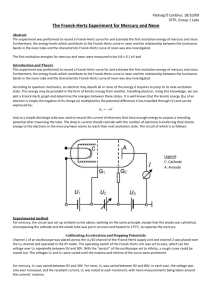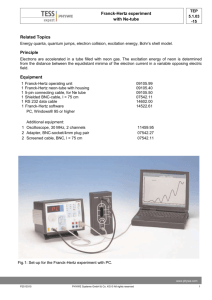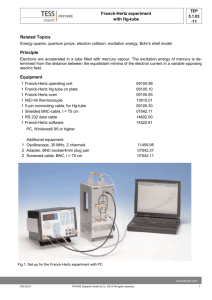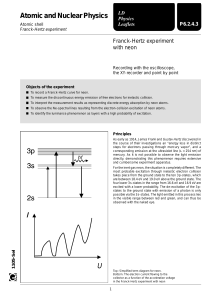The Franck-Hertz Experiment
advertisement
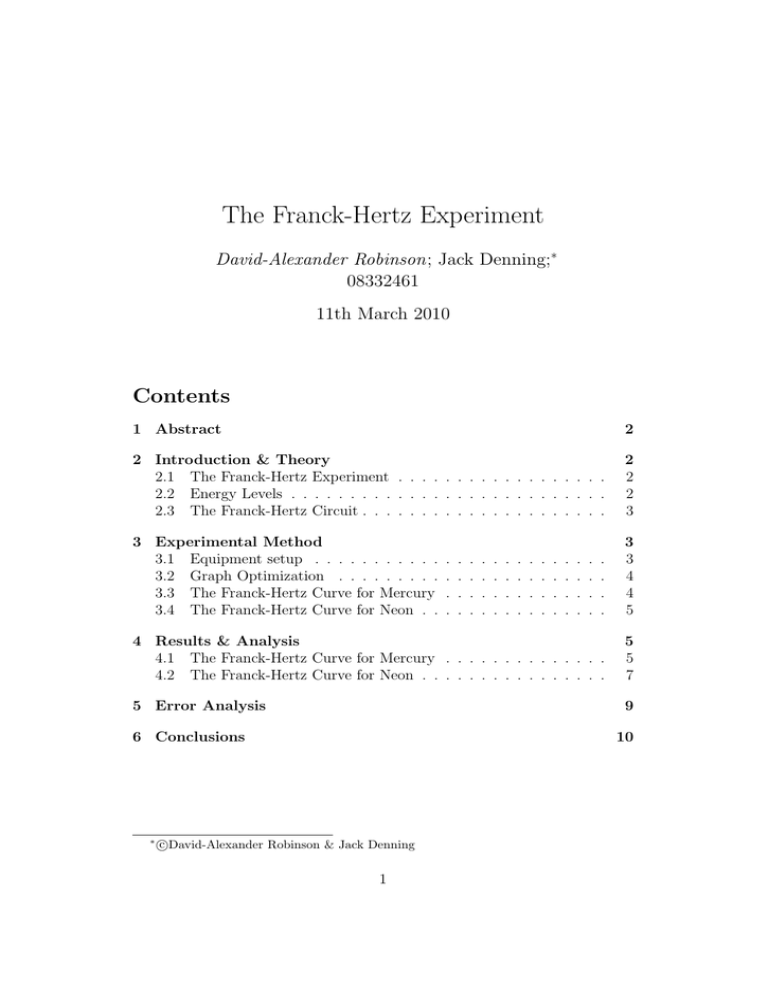
The Franck-Hertz Experiment David-Alexander Robinson; Jack Denning;∗ 08332461 11th March 2010 Contents 1 Abstract 2 2 Introduction & Theory 2.1 The Franck-Hertz Experiment . . . . . . . . . . . . . . . . . . 2.2 Energy Levels . . . . . . . . . . . . . . . . . . . . . . . . . . . 2.3 The Franck-Hertz Circuit . . . . . . . . . . . . . . . . . . . . . 2 2 2 3 3 Experimental Method 3.1 Equipment setup . . . . . . . . . . . 3.2 Graph Optimization . . . . . . . . . 3.3 The Franck-Hertz Curve for Mercury 3.4 The Franck-Hertz Curve for Neon . . . . . . 3 3 4 4 5 4 Results & Analysis 4.1 The Franck-Hertz Curve for Mercury . . . . . . . . . . . . . . 4.2 The Franck-Hertz Curve for Neon . . . . . . . . . . . . . . . . 5 5 7 5 Error Analysis 9 6 Conclusions ∗ . . . . . . . . . . . . . . . . . . . . . . . . . . . . . . . . . . . . . . . . . . . . . . . . . . . . 10 c David-Alexander Robinson & Jack Denning 1 1 Abstract In this experiment the first excitation potential of gaseous mercury and neon atoms was investigated using the Franck-Hertz partial current method. The values of the potential found were 5.1 ± 0.4eV and 19.2 ± 0.5eV respectively. These agree with the accepted values of 4.9eV and 18.4-19.0eV respectively. A graph of the Accelerator Voltage versus the Current (in the form of the Stopping Voltage) was plotted for each gas. 2 2.1 Introduction & Theory The Franck-Hertz Experiment The Franck-Hertz experiment, preformed in 1914, is an experiment for confirming the Bohr Model of that atom. It was found that when electrons in a potential field were passed through mercury vapour they experienced an energy loss in disinct steps, and that that the mercury gave an emission line at λ = 254nm. This was due to collisions between the electrons and the mercury atoms. 2.2 Energy Levels If the Franck-Hertz Experiment is carried out using neon gas the emission spectrum is in the visible range of the electromagnetic spectrum. The neon atoms can be excited to only a speific number of sub-energy levels. There are ten 3p-states, which are between 18.4eV and 19eV from the ground state, and four 3s-states at 16.6eV to 16.9eV from the ground state. When an atom is excited its electrons can only move to speific energy levels depending on the selection cretiera of the atoms quantum numbers n, l, ml and ms . ∆l = ±1 (1) ∆ml = ±1, 0 (2) 2 Figure 1: Energy level transitions 2.3 The Franck-Hertz Circuit The apparatus consists of glass tube containing the circuitry. An electrode emits electrons when heated, which are attracted to a grid system by a driving potential across the glass tube of U1 . The grid consists of two layers, G1 and G2 between which is the accelerating potential U2 . Finally, there is a collector A outside of G2 with a breaking voltage U3 between them. As the accelerating potential U2 is increased the collector current IA increases to a maximum until the electrons have enough energy to transfer to and excite the mercury atoms through collisions, which is E = 4.9eV. As such the collector current then drops off, as after collision less electrons are able to overcome the breaking voltage U3 . As U2 is increased further the electrons can again excite the mercury atoms, and another maximum is found. This process is repeated. 3 3.1 Experimental Method Equipment setup With the power supply unit turned off, the oven and the oscilloscope were connected. The variables U1 , U2 and U3 were all set to zero, and the power supply was turned on. The operating mode was set to MAN. 3 Finally, the heater was set to ϑ = 175o C and allowed to heat up for 15mins. The oscilloscope was set to XY-mode and the infinite option was selected to retain the plot of the curve. 3.2 Graph Optimization The Franck-Hertz tube was first set up to give an optimal graph. That is one of the form Figure 2: A typical Franck-Hertz curve which does not rise too steeply, is not too flat, and which has well defined maxima and minima which are not cut off at the bottom. This is done by adjusting the values of the driving potential U1 , which should be around 1.5V, and breaking voltage U3 which should be around 1.5V. 3.3 The Franck-Hertz Curve for Mercury A multimeter was connected to measure the Collector Voltage V in place of the Collector Current IA . The Accelerating Voltage U2 was slowly increased from 0 to 30V to produce a curve on the oscilloscope. The value of the accelerating voltage U2 and collector voltage V were recorded for a range of values of accelerating voltage, with a number of measurements taken around the maxima and minima of the curve. 4 A graph of the collector voltage V versus accelerating voltage U2 was plotted. From this the first excitation energy of mercury ∆U2 was calculated by measuring the separation between the successive maxima. The value of the contact potential was calculated using the formula G = U1 + U2 − ∆U2 (3) Finally, the mean free path of an electron in mercury vapour at a temperature of 160o was calculated using the equation kB T (4) µ= √ 2πd2 P where kB is Boltzmann’s constant, T is the temperature, d is the diameter of the mercury molecules and P is the pressure. 3.4 The Franck-Hertz Curve for Neon The apparatus was turned off and allowed to cool down. The mercury source was disconnected, and the neon gas tube was connected instead. Each of U1 , U2 and U3 were all set to zero and the power supply unit was turned on, with the operating mode still set to MAN. Once on, U1 was set to 1.53V and U3 to 10.25V. The Accelerating Voltage U2 was then slowly increased from 0 to 80V, again to produce a curve on the oscilloscope, and the value of the accelerating voltage U2 and collector voltage V were recorded for a range of values of accelerating voltage, with a number of measurements taken around the maxima and minima of the curve. The voltages that caused luminance bands to appear in the neon tube were recorded for one, two and three luminance bands respectively. Again, a graph of the collector voltage V versus accelerating voltage U2 was plotted, and from this the first excitation energy of neon ∆U2 was calculated by measuring the separation between successive maxima. 4 4.1 Results & Analysis The Franck-Hertz Curve for Mercury The variables U1 and U3 were set to 3.8V and 1.6V respectively to optimize the curve on the oscilloscope. The following data was recorded for the Mercury Frank-Hertz curve 5 Accelerating Voltage, Collector Voltage, U2 (V ) ± 0.1 V (V ) ± 0.03 0 0.00 0.4 0.00 1.4 0.02 2.4 0.16 3.4 0.58 4.4 0.26 5.4 0.10 6.4 0.37 7.4 1.28 7.9 1.83 8.4 2.12 8.9 1.49 9.6 0.54 10.1 0.30 10.6 0.38 11.3 0.86 12 1.72 12.8 3.82 13.3 4.39 13.8 3.12 14.1 1.99 14.4 1.17 14.7 0.86 15.2 0.63 15.7 0.86 16.3 1.43 17 2.88 17.6 5.05 18.1 6.17 18.6 5.38±0.1 19 3.75 19.4 2.48 19.8 1.78 20.3 1.47 20.8 1.73 21.5 2.56 22.1 4.29 22.8 7.40 23.3 8.31 23.8 7.21±0.05 24.2 5.13 6 24.6 4.03 25.1 3.33 25.6 3.28 26.1 3.50 26.7 4.64 27.5 7.95 28.1 10.6±0.05 28.6 11.15±0.3 29.1 9.90±0.1 29.5 7.95 30.3 6.93 30.8 6.71±0.1 31.3 7.40±0.1 With this the following graph was plotted Figure 3: The Frank-Hertz Curve for Mercury The Mean free path was calculated to be 37.18µm using equation 4, where kB = 1.3 × 10−23 , P = 11.28mm Hg ≡ 1495Pa, ϑ = 160 + 273.15 = 433.15K and d = 151 × 10−12 m. 4.2 The Franck-Hertz Curve for Neon The following data was recorded for the Frank-Hertz curve for Neon 7 Accelerating Voltage, Collector Voltage, U2 (V ) ± 0.2 V (V ) ± 0.03 0 0.03 3.3 0.04 6.7 0.04 58.5 2.23 10.4 0.04 60.2 0.67 12.7 0.97 61.9 0.01 14 1.35 62.9 -0.03 17.3 2.06 63.9 0.07 18.3 2.14 65.6 0.72 19.3 1.50 67.3 2.08 20.4 0.61 69 3.84 21.6 0.03 70.6 5.55 22.6 -0.04 72.3 6.77 23.6 -0.06 74 7.42 27 -0.06 75 7.41 28 -0.01 76 7.32 29 1.17 76.3 7.28 30.8 2.43 77.6 6.73 31.5 2.81 78.9 6.37 34.3 3.97 79.9 5.93 35.3 4.17 36.3 3.66 37.5 2.61 38.7 1.43 39.9 0.43 40.9 -0.03 41.9 -0.06 45 -0.07 46 -0.04 47 0.56 48.3 1.57 49.7 2.81 50.8 3.76 51.7 4.49 52.6 5.06 53.6 5.10 54.6 4.98 56 4.20 57.3 3.28 8 and again the following graph was plotted using the data Figure 4: The Frank-Hertz Curve for Neon The red-orange luminance bands were seen at equal intervals of accelerating potential as follows Number of Luminance Bands Accelerating Potential, U2 (V) 1 35.3 2 53.6 3 75.0 5 Error Analysis The error on the measurements for the accelerating potential U2 was taken to be ±0.1 for the Mercury experiment as this was the machine gave a reading to the first decimal place. For the Neon experiment the error was taken to ±0.2, as the larger range in the potential had a larger uncertainty. For the error in the collector voltages V, an uncertainty of ±0.03 was taken due to the slight fluciations that occurred when reading the mulitmeter. There was a larger uncertainty given to some of the values for a high 9 accelerating potential during the mercury experiment due to larger fluciations on the multimeter. Finally, for calculating the error in ∆U for both mercury and neon the following relation was used. ∆U = U v u n uX ×t 1 ∆U2,n U2,n where n was the index of the peek differences. 6 Conclusions In this experiment we calculated the the first excitation potential of mercury atoms, which was found to be 5.1 ± 0.4eV. This agrees with the accepted value of 4.9eV within the limits of experimental error. The contact potential was found to be 7.1 ± 0.4eV. The mean free path of an electron in mercury vapor was found to be 37.18µm using the above equation. We conclude that electrons excite mercury atoms to descret energy levels, and the excited mercury atoms can then loose this energy by emitting photons in the ultraviolet light range. Secondly, we calculated the the first excitation potential of neon atoms, which was found to be 19.2 ± 0.5eV. Again, this agrees with the accepted value of 18.4 to 19.0eV within the limits of experimental accuracy. This corresponds to the neon atoms being excited to the 3p energy levels. This excitation is clearly more probable, since it was recorded to occur for every excitation, and we can determine that this was the only excitation to occur. From our table for the number of luminance bands, we can see that the luminance bands correspond to the peeks of the Franck-Hertz curve. Thus we expect the next band, that is the fourth, to occur at 94.2 ± 0.5eV. 10
